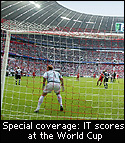SBS adds server muscle to World Cup defence

The lead Web developer of SBS' digital media division Rebecca Smith said the qualification alone of Australia's national Socceroos team had caused a spike in interest in SBS' "The World Game" site.
"We had 400,000 page impressions on the day after they qualified," Smith told ZDNet Australia in a telephone interview, adding while it did not have exact estimates, the broadcaster expected a similar daily total during the upcoming June competition.
"For the last World Cup, we had seven million impressions in a month. That was about 233,000 per day," she said.
In Australia, SBS is the official broadcaster of the month-long tournament.
SBS will host the World Cup site from its Sydney headquarters on three brand new Sun Fire v240 servers, with a fourth expected to be added soon.
A BIG-IP traffic load balancer has also been added to the setup. The hardware from F5 Networks is expected to deliver a 50 percent increase in performance.
Sun's participation doesn't end there however, with the vendor hosting a mirror of the Web site from its Sydney data centre. That setup will feature six v240 servers in addition to a BIG-IP load balancer.
This temporary support deal will keep The World Game site online even if SBS's own infrastructure is knocked offline for any reason.
The setup is quite different from that of the last World Cup, which SBS also broadcast.
"For the last World Cup we had a cluster of [six] servers and borrowed a machine from Sun," said Smith. "But the three new servers are significantly larger."
Three was the key word when it came to SBS' evaluation of the infrastructure needed to cope with the expected increase in traffic this year.
"We thought we'd need basically three times what we had for the last World Cup," said Smith. "Everything has been done by about three times because of the amount of people we expect visiting the site."
SBS' old blade servers from the last World Cup would be put into a new cluster to serve other Web content, according to Smith. The new servers would run other SBS Web sites post-tournament.
Renovations
SBS' back-end infrastructure is
not the only asset to have been upgraded in preparation for this
year's World Cup.
The World Game site itself has been completely redeveloped in the leadup to the tournament, with Smith herself focusing solely on the upgrade.
"It was a good time for a redesign, we try and keep the site as up to date as resources allow," the Web developer said.

The new site allows access to every news story since 2000. The digital media team also worked hard to cross-promote SBS sites and make more content easily accessible.
Behind the scenes, a PHP templating engine called Smarty was employed to reduce stress on the site's MySQL database.
"We've significantly improved our database, so no-one really hits the database anymore," Smith added.